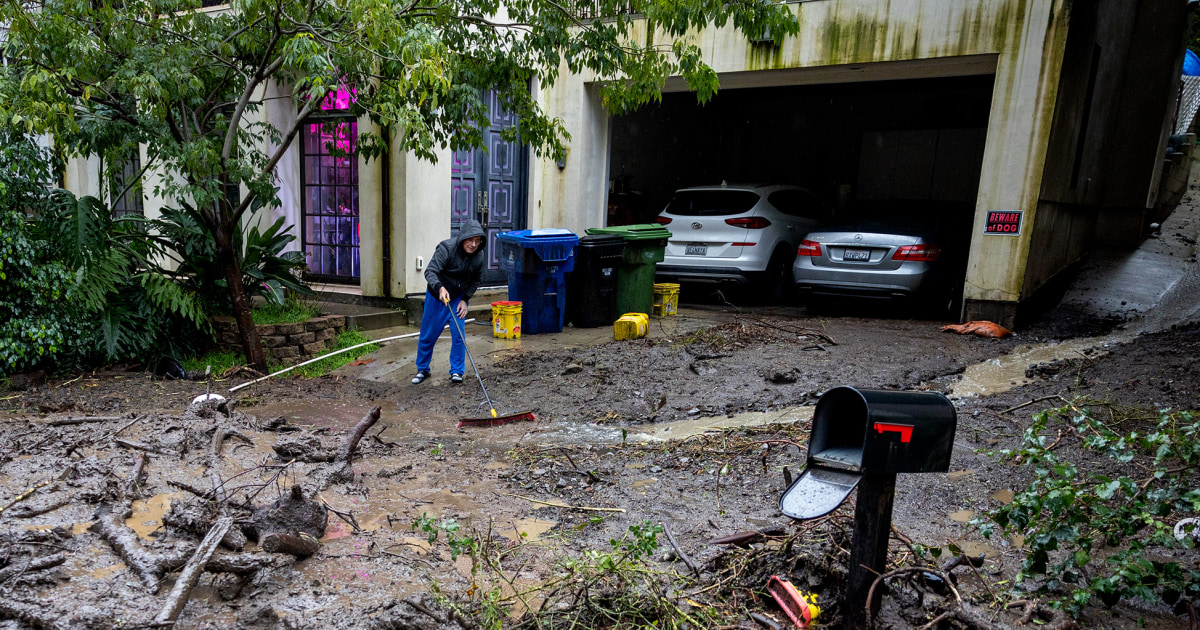Another difficult week is expected for California, as two storms will hit the state from this Saturday to Wednesday, bringing more torrential rain to the region.
More than 27 million people are under flood alert.
The first storm system arrives in Northern California this Saturday, bringing heavy rain from Eureka to Santa Rosa.
Flood warnings have been issued throughout the region.
Up to an inch of rain is possible per hour, resulting in a total of 3 to 4 along the coast.
In San Francisco, rain arrived overnight Friday and will last through Tuesday.
The city should expect about 1 to 3 inches total.
A resident tries to sweep mud and debris from the driveway of his home in Beverly Crest, California, on February 5, 2024. Allen J. Schaben / Los Angeles Times via Getty Images
The atmospheric river will move south on Sunday, extending just north of Los Angeles, according to NBC News meteorologists.
The second storm will arrive in Southern California on Monday, with heavy rain from San Luis Obispo to Los Angeles.
Flood alerts will be in effect from Sunday night until Wednesday.
Landslides and mudslides are a major concern in the region.
“Soils around the Bay Area are near saturation, so rain will run off quickly and will likely contribute to numerous shallow landslides along areas of steep terrain,” the National Weather Service office said. in San Francisco.
Santa Barbara should prepare for the heaviest rain Sunday through Monday;
They will fall between 2 and 5 inches total.
Los Angeles can expect rainy conditions Sunday through Wednesday.
Lower elevation areas could see around 2 to 5 inches, while 4 to 8 are expected in the foothills and mountains.
In addition to heavy rain, 1 to 2 feet of snow is expected to fall in the Sierras and 1 to 3 inches on Mount Shasta.
“Mountain travel is strongly discouraged while the warning is in effect, as potential impacts include difficult or impossible travel conditions, snow-covered roads, chain checks, reduced visibility and road closures,” the Service office added. National Weather Service in Sacramento.
[Nine people died in California in four days of storm. The number may increase]
Strong gusts of wind are also expected, but not as strong as those that occurred at the beginning of the month that left hundreds of thousands of people without electricity.
Officials believe it will be 35 to 50 mph overnight Sunday and into Monday.
There is a warning of possible downed trees and power outages.
The latest atmospheric river storm hit Southern California early last week, with days of heavy rain causing flooding and mudslides.
The two storms of these days - the second stronger than the first - are not expected to be as devastating and deadly as the past ones, but the constant rains and the slow pace of the second cause a significant threat of flooding.
Downed trees and utility lines left thousands of homes and businesses in the state without power.
At least three people died in incidents
involving falling trees.
Atmospheric rivers are common weather phenomena, especially on the west coast.
The rainfall associated with these storms is closely linked to the annual water supply and flood risks.
As climate change continues to warm the planet, atmospheric rivers are expected to increase in frequency and intensity, becoming more dangerous.
Research suggests that by 2090, these storms could cause between $2.3 and $3.2 billion in damage each year.
With information from
NBC News
and
CNN

